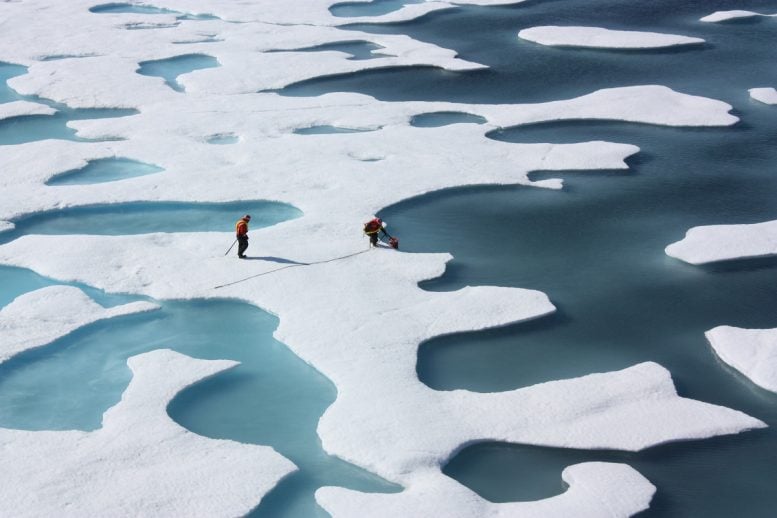
Changes in the melting patterns of Antarctica and the slushy condition of Arctic ice are driving global warming toward the upper limits predicted by climate models.
New research led by scientists at the University of Michigan reveals that the Arctic has lost approximately 25% of its cooling ability since 1980 due to diminishing sea ice and reduced reflectivity. Additionally, this phenomenon has contributed to a global loss of up to 15% in cooling power.
Using satellite measurements of cloud cover and the solar radiation reflected by sea ice between 1980 and 2023, the researchers found that the percent decrease in sea ice’s cooling power is about twice as high as the percent decrease in annual average sea ice area in both the Arctic and Antarctic. The added warming impact from this change to sea ice cooling power is toward the higher end of climate model estimates.
“When we use climate simulations to quantify how melting sea ice affects climate, we typically simulate a full century before we have an answer,” said Mark Flanner, professor of climate and space sciences and engineering and the corresponding author of the study published in Geophysical Research Letters.
“We’re now reaching the point where we have a long enough record of satellite data to estimate the sea ice climate feedback with measurements.”

The Arctic has seen the largest and most steady declines in sea ice cooling power since 1980, but until recently, the South Pole had appeared more resilient to the changing climate. Its sea ice cover had remained relatively stable from 2007 into the 2010s, and the cooling power of the Antarctic’s sea ice was actually trending up at that time.
Antarctic Ice Stability and Decline
That view abruptly changed in 2016, when an area larger than Texas melted on one of the continent’s largest ice shelves. The Antarctic lost sea ice then too, and its cooling power hasn’t recovered, according to the new study. As a result, 2016 and the following seven years have had the weakest global sea ice cooling effect since the early 1980s.
Beyond disappearing ice cover, the remaining ice is also growing less reflective as warming temperatures and increased rainfall create thinner, wetter ice and more melt ponds that reflect less solar radiation. This effect has been most pronounced in the Arctic, where sea ice has become less reflective in the sunniest parts of the year, and the new study raises the possibility that it could be an important factor in the Antarctic, too—in addition to lost sea ice cover.

“The changes to Antarctic sea ice since 2016 boost the warming feedback from sea ice loss by 40%. By not accounting for this change in the radiative effect of sea ice in Antarctica, we could be missing a considerable part of the total global energy absorption,” said Alisher Duspayev, doctoral student in physics and the study’s first author.
The research team hopes to provide their updated estimates of sea ice’s cooling power and climate feedback from less reflective ice to the climate science community via a website that is updated whenever new satellite data is available.
“Climate change adaptation plans should bring aboard these new numbers as part of the overall calculus on how rapidly and how widely the impacts of cryospheric radiative cooling loss will manifest on the global climate system,” said Aku Riihelä, research professor at the Finnish Meteorological Institute and co-author of the study.
Reference: “Earth’s Sea Ice Radiative Effect From 1980 to 2023” by A. Duspayev, M. G. Flanner and A. Riihelä, 17 July 2024, Geophysical Research Letters.
DOI: 10.1029/2024GL109608
The research was funded by the University of Michigan Rackham Graduate School and the Research Council of Finland.
2 Comments
“…, wetter ice and more melt ponds that reflect less solar radiation.”
That may be the case — or not. Water can have a higher (specular) reflectance than even fresh snow, let alone old snow. It depends on the time and location of the melt ponds. During the Arctic Summer, when the sun never sets, water may have a specular reflectance lower than the snow albedo when the sun is highest in the sky; however, when the sun is low on the horizon, the situation is probably reversed.
The single picture at the top of the article is not a general representation of the situation. While the meltwater ponds may look darker than the snow in the picture, there is considerable light being reflected off the water. The difference is, the snow reflects in all directions (diffuse reflectance), looking uniformly bright. However, all the light reflected specularly is confined to a thin sheaf of rays that are only visible if one is looking towards the sun and down on the water at the angle of solar incidence. At that position it is blindingly bright! It is not unlike what one experiences driving a car facing the sun, on wet pavement with no clouds. However, if one were flying over the same road in a small plane and looking straight down, the asphalt road would look quite dark.
The Greenland Ice Sheet east of Thule AB was “slushy” when I was working there in July 1966. This is not something new.
Not only is the public being misled by inexperienced researchers, but we are failing the current generation of researchers themselves by providing them with a less than comprehensive education.
The article, showing Mark Flanner in light clothes, makes it sound like the ice is responsible for the Arctic being cold when the “cooling power” is talked about. It is the opposite. The ice is present because it is at the poles where the sun is always low in the sky — when it isn’t dark — and it is also often overcast. Therefore, sunlight has a large ‘footprint,’ and a long scattering path-length, reducing the amount of warming. Also, both water and even snow have strong forward reflectance that isn’t even measurable by most imaging satellites.